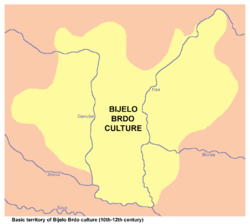Bijelo Brdo culture
The Bijelo Brdo culture[1][2] or Bjelo-Brdo culture[3] is an early medieval archaeological culture flourishing in the 10th and 11th centuries in Central Europe. It represents a synthesis of the culture introduced in the Carpathian Basin by the conquering Hungarians around 900 and of earlier cultures existing in the territory (in present-day Croatia, Hungary, Romania, Serbia and Slovakia) before the Hungarian conquest.[4] Female dress accessories, including "jewellery of plaited wire, two-piece sheetwork pendants, snake-head bracelets and S-shaped temple-reings" (P. M. Barford),[4] are the most characteristic items of the culture.[3] The culture disappeared around 1100, most probably not independently of laws adopted under Kings Ladislaus I and Coloman of Hungary which prescribed the burial of dead in graveyards developed near churches.[3]
Initially it was thought that the poorer Hungarian(Magyar) gravesites were Slavic and that only the rich horse-warrior burials were Hungarian. This view was challenged in the 1940s and is now rejected by Hungarian scholars, who see the poorer burials as Magyar commoners, such as Béla Szőke.[5]
It is named after an archeological site, a medieval graveyard found near the village of Bijelo Brdo, Croatia and excavated since 1895.[6] The dating at 7th Century of Site 1 was established by Zdenko Vinski.[7]
According to the Russian archaeologist Valentin Vasilyevich Sedov, the basic territory of Bijelo Brdo culture included territory of present-day Hungary, southern Slovakia and part of Serbian Vojvodina.[8]
See also
- History of Christianity in Hungary
- History of Christianity in Romania
- History of Christianity in Slovakia
- Hungarian conquest of the Carpathian Basin
Footnotes
- ↑ Engel 2001, p. 17.
- ↑ Spinei 2003, p. 57.
- 1 2 3 Curta 2006, p. 192.
- 1 2 Barford 2001, p. 231.
- ↑ Geary, Klaniczay, Patrick (2013). Manufacturing Middle Ages (First ed.). Brill. pp. 221, 223. ISBN 9004244867. Retrieved 2015-08-01.
- ↑ Vodanović, Brkić & Demo 2005.
- ↑ Bože Mimica Slavonija u XX. stoljeću 2009 Page 332 "Nalazište Bijelo Brdo I. arheološki je pouzdano datirao Zdenko Vinski (1913-1996) u sredinu ili drugu polovicu 7. stoljeća."
- 1 2 Valentin Vasiljevič Sedov, Sloveni u ranom srednjem veku, Novi Sad, 2013, pages 419-421.
- ↑ http://www.dodaj.rs/f/3d/PP/bVFVG7O/bijelobrdo.jpg
References
- Barford, P. M. (2001). The Early Slavs: Culture and Society in Early Medieval Eastern Europe. Cornell University Press. ISBN 0-8014-3977-9.
- Curta, Florin (2006). Southeastern Europe in the Middle Ages, 500-1250. Cambridge University Press. ISBN 978-0-521-89452-4.
- Engel, Pál (2001). The Realm of St Stephen: A History of Medieval Hungary, 895-1526. I.B. Tauris Publishers. ISBN 1-86064-061-3.
- Spinei, Victor (2003). The Great Migrations in the East and South East of Europe from the Ninth to the Thirteenth Century (Translated by Dana Bădulescu). ISBN 973-85894-5-2.
- Vodanović, Marin; Brkić, Hrvoje; Demo, Željko (February 2005). "Paleostomatološka analiza humanog kraniofacijalnog osteološkog materijala sa srednjovjekovnog nalazišta Bijelo..." [Paleostomatological analysis of human cranial osteological material from the mediaeval site of Bijelo Brdo near Osijek]. Journal of the Zagreb Archaeological Museum. Archaeological Museum, Zagreb. 37 (1). ISSN 0350-7165. Retrieved 2013-04-10.
